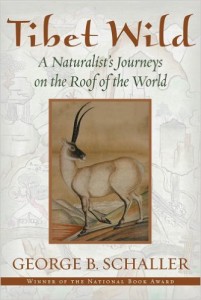
Tibet Wild by George Schaller.
Have you ever wondered what it’s really like to be a conservationist? To have the recognition of being the person saving tigers, or polar bears, or elephants?
What’s it like to spend your life protecting wildlife and wild places, often in some of the remotest areas of the world?
What do conservationists endure, are they in constant danger, how do they accomplish anything among the political, environmental, and physical obstacles of their lives chosen work?
I interviewed George Schaller for my newest book, Wild Lives, co-authored with Janie Chodosh, (Skyhorse Publishers, April 2017).
As a great naturalist and conservation scientist Schaller has probably helped save more wildlife and wild lands than anyone on the planet, yet I found him to be humble and self-effacing.
He confesses to subscribe to the dictum of Ralph Waldo Emerson, “Do not go where the path may lead, go where there is no path and leave a trail.”
And that is exactly what Schaller has spent his life doing.
His methods continue to be informed by the late wildlife biologist, Olaus Murie, who taught Schaller to pay attention to the ‘intangibles’ of a place.
“Natural history remains the cornerstone of conservation. It must be learned on the ground, asking questions, observing, listening, taking notes, getting the boots muddy. Technology helps to open the world but technology can also close it unless one learns directly from nature.”
His projects in the 1960’s on gorillas, tigers, and lions had been conducted in national parks, which he says, “had a measure of security, but …I felt, contributed little to conservation.”
During the next decade Schaller focused on projects on new species in new areas which had been ignored or neglected. He wanted “to give voice to animals which have had no one to speak on their behalf.”
That led him to the Tibetan Plateau. “Tibetan Buddhism distinguishes 18 kinds of ‘void’, and this landscape, a place of desolation and emptiness, yet possessing a raw, haunting beauty, is another such void,” he says.
His struggles to help protect the unique ecosystem of the Tibetan Plateau, particularly the northern upland area called the Chang Tang are the focus of his book Tibet Wild, A Naturalist’ Journeys on the Roof of the World.

“The wind barrels out of the west unimpeded over hundreds of empty miles. It scours the bald peaks and blasts across lake flats, howling with a wolf’s voice and throwing up curtains of dust; it rips at the clothes, pounds the body, and abrades the face,” he writes in Tibet Wild. Yet George Schaller has been returning to this place for three decades.
“I still sleep in cold tents, frost crystals around my face in the morning, where its -29 degrees at dawn and my toothpaste is frozen solid. “
At the age of 83 he is still visiting.
“The desolation and boundless emptiness is to me what makes this wilderness so exceptional, and its perils have left it beautiful, largely devoid of development. I find my emotional center and am comfortable in a place like this. Certainly it suits my inner landscape, reflecting a certain self-contained spirit.”
In the book you get a sense not only of the work of a famous conservationist but also the doubts and inner landscape of the man. In over half a century of field work Schaller ponders, “What am I accomplishing? Why am I doing the same kind of work decade after decade, though in different places?”
“I strive to do solid science and promote conservation, but, at the same time, I seek a life outdoors, in part a self-indulgent escape from a daily routine,” he admits.
You can learn more about Schaller’s life and work in Wild Lives.
And I highly recommend Tibet Wild, A Naturalist’s Journeys on the Roof of the World by George Schaller.
** Feature photo by Beth Wald. George Schaller (on right) measuring the horns of a Marco Polo sheep in the Wakhan Corridor of northeastern Afghanistan during a wildlife survey in 2004.
**George Shaller is the VP of Panthera and senior conservationist at the Wildlife Conservation Society.
2 Replies to “Inside the Life of Conservationist George Schaller”
Comments are closed.

Lori ; Thanks for this interesting and informative E-mail.
That’s true, animals must have a voice .